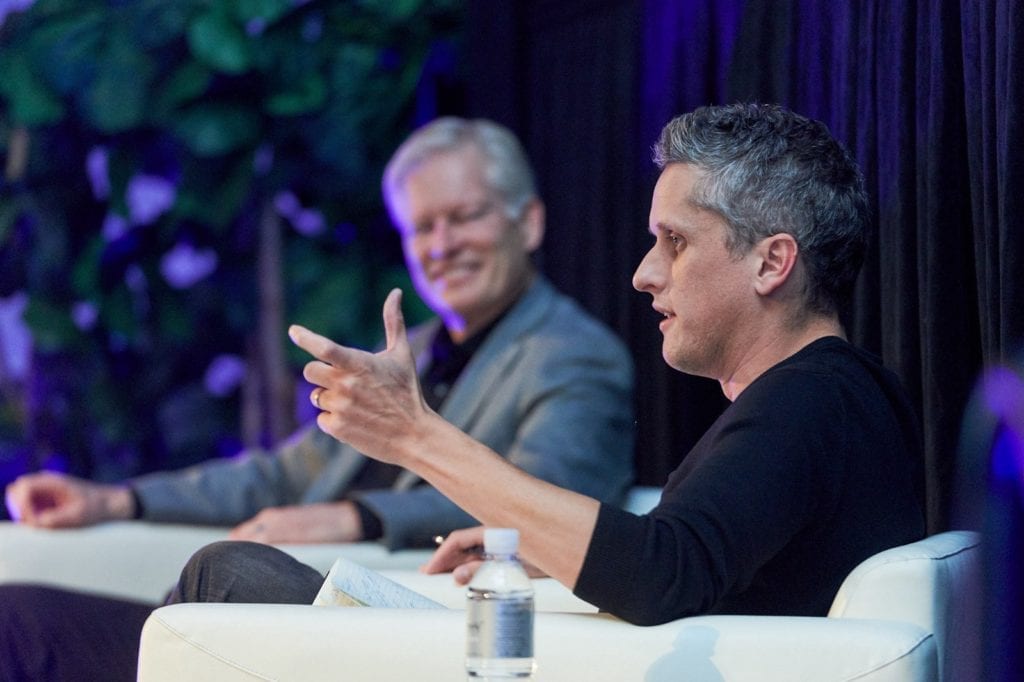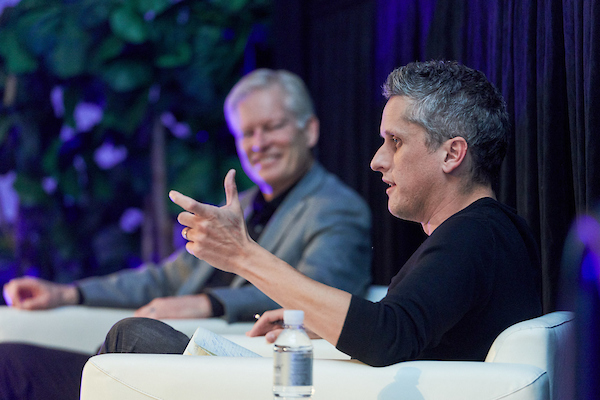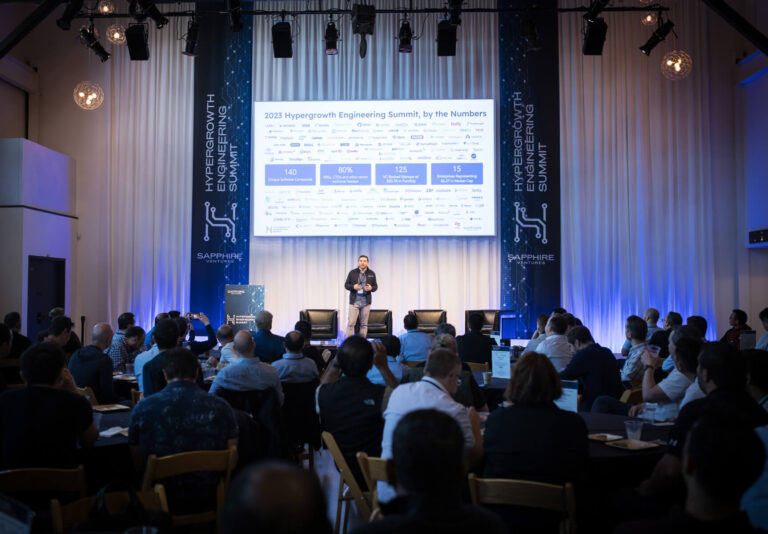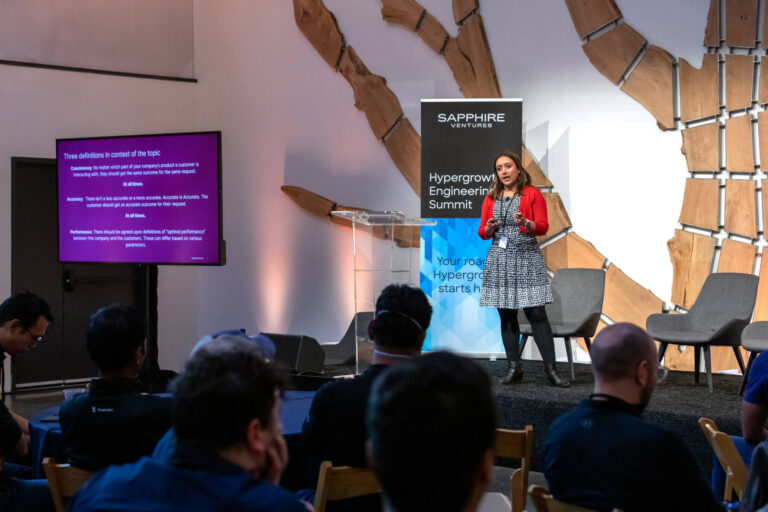Sapphire Ventures recently brought together business and IT leaders representing more than $63B in annual IT spend for our CIO Summit 2018 — a 2-day exploration of emerging trends and tools driving today’s successful companies. Featured speakers included:
· Chris Anderson, former editor of Wired and the current CEO of 3DR;
· Aaron Levie, CEO of Box
· Bruce MacGregor, an IDEO partner;
· and Norm Fjeldheim, CIO and Head of Global Facilities for Illumina

Aaron Levie and Norm Fjeldheim share the stage at CIO Summit 2018
For attendees, the annual CIO Summit provides a forum for exchanging best practices and swapping stories from the trenches. Presentations, breakout sessions, and networking enables CIOs to connect with peers addressing similar business challenges — and often, to be connected with, tech startups in attendance with solutions that address those issues.
This year’s conversations revolved around:
• How AI is (and is NOT) transforming the workplace
• How CIOs can enable new paradigms for employee collaboration
• The role CIOs can play in engaging non-traditional stakeholders such as customers, external vendors, and the developer community.
This last topic highlights a trend we’ve identified in prior years: the role of the chief information officer is fundamentally changing. CIOs continue to call out that their role is evolving from internally-facing, “keep-the-lights-on” activities to a role that is more externally, and focused on value-add activities. One way CIOs are making this transition is by proactively finding and adopting emerging technologies to improve their organization’s infrastructure and operations.
This year’s Summit focused on the Future of Work, and the unique role CIOs play in future-proofing their organization.
There were three common calls-to-action CIOs highlighted at this year’s Summit:
1) Enhance existing jobs with intelligent systems
When many people think of AI in the workplace, they envision human-like robots taking over and leaving large segments of the population unemployed. This dystopian future couldn’t be further from current practice. While robots and AI are set to take over millions of existing jobs in the next several years, they will be focused far more on “boring” tasks (in the words of Databricks CEO Ali Ghodsi) than general-purpose human replacements.
While many acknowledged that AI has been over hyped, attendees agreed that AI’s increasing ability to take over mundane tasks can increase productivity and add tremendous organizational value.
Far from leaving millions unemployed, intelligent systems will create even more opportunities, freeing up humans for complex and creative work. Today’s AI hype tends to focus on more exotic applications such as self-driving cars, but there are literally thousands of uses for “boring AI” to sort through the repositories of data enterprises have access to.
Chris Anderson highlighted this trend in his opening keynote, focusing on how even such a physical world industry such as construction, can leverage AI to address repetitive and dispassionate work like performing site scans.
Ali Ghodsi urged CIOs to shift their thinking on AI from an “era of replacement” to one of “enhancement” — where integrating intelligent systems into daily workflows make teams faster, smarter and help them deliver higher-quality products overall.
2) Improve financial results through stronger customer engagement.
Measuring customer engagement alongside top- and bottom-line growth isn’t new. Companies like Amazon have been doing it (with enormous success) for decades. What’s changing today is the level of detail teams get into when studying their end users, and the impact it can have on the business.
Tracking monthly active users used to be enough, but today’s tools allow companies to measure data like product breadth (users per account), depth (how many of a product’s core features customers engage with), and even frequency (how often users log in to a product in a certain time frame) on a near real-time basis.
Customers are smarter than ever and their expectations are rapidly evolving. With easy access to information and low switching costs, consumers are continually optimizing for quality and price. It’s up to companies to stay up to date with consumer needs and expectations, and rapidly respond — and this is where CIOs can directly impact business performance.
CIOs have a strong role to play in helping their organizations better understand customers on a granular level. Tools are emerging to help teams track the movements of customers on company platforms and make communication more personal and relevant. Pendo cofounder and CEO Todd Olson and LeanData cofounder and CEO Evan Liang discussed how companies zeroing in on these metrics are better able to update existing products, develop new ones, and delight customers.
While top-line growth is important, teams that lean into customer engagement often realize greater revenue over time, due to higher retention rates and cross-sell and upsell opportunities.
SAP’s Adaire Fox-Martin and Pendo’s Todd Olson discuss the opportunity to engage customers in the New Economy.
3) Adapt to a changing workplace with new tools and emerging technologies.
As technology evolves, so does the way we work. CIOs can help drive this organizational shift by leveraging recent developments in tech — from investing in new collaboration tools like Workplace by Facebook, to utilizing tools to increase developer speed and agility.

The most successful engineering teams — and, by extension, the most nimble and productive companies — execute quickly yet remain open to new ways of working. Microsoft’s Julia Liuson pointed out that it’s time to throw out the old rule book for measuring the productivity of a developer. Today, the best tools can win at the grass roots level with developers before a CIO is even aware they are being used in the organization. Companies like JFrog, which automates and secures developer processes, can free up teams to be more creative and ultimately deliver higher-quality products and services.
Staying on the front lines of innovation is essential to being a successful CIO, and yet staying on top of emerging technologies can be like drinking from a fire hose. To help CIOs and their colleagues, Sapphire Ventures revealed SV Explorer, a soon to be launched innovation discovery tool that will help CIOs identify, evaluate, and share profiles of start-ups that have built emerging technologies of potential value. SV Explorer taps into Sapphire’s portfolio of disruptive technologies, as well as over 40 top-tier venture partners across the globe. SV Explorer launches publicly in later in 2018 to help innovative Global 2000 companies drive digital transformation in their organizations.
CIOs: Adapting Your Organization to Survive
Organizations that can adapt to new consumer expectations and the changing business environment will survive, while others will become irrelevant. We’ve seen this trend play out in real time with decreasing life spans of companies on the Fortune 500 — down to just 20 years from 60 in the 1950s. In 2017, 15 companies dropped off the list, including heavyweights like KKR, Hess, and Barnes & Noble.
With the pace and volume of work increasing, CIOs are juggling many moving parts as they try to steer their organizations in the future. For CIOs to be successful in this, it’s critical to stay informed on emerging technologies to predict and adapt to the disruptions their industries and organizations will face. Events like Sapphire’s CIO Summit enable CIOs to stay on top of emerging trends, and network with their peers.
Stay tuned for deeper dives into content from the CIO Summit 2018 in the coming weeks.



